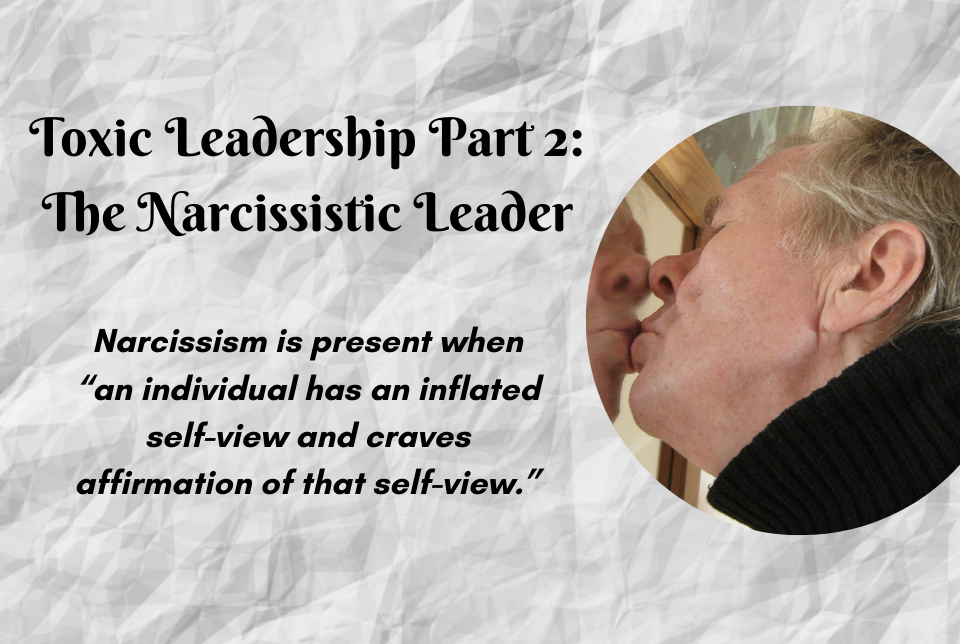Toxic vs. Servant Leadership (Part 1): The Self-Focused Leader
I am sure that all of us have worked at some time or another for a toxic leader; a leader who creates a dangerous atmosphere that seems to suck all of the positive energy out of the workplace. When we think back to our times working for such leaders, we remember a strong environment of fear; an almost oppressive weight that negatively affects our motivation, creativity and commitment. Maybe you work now for such a leader. If so, my hope is that this article, along with a couple to follow, will provide some understanding of what drives this kind of leader and why this mindset of leadership is so harmful.
 There is a basic mindset that drives all of us and we find this mindset along a continuum from a focus on self to a focus on others. Adam Grant breaks this down into three categories; givers, takers and matchers. Givers are other-focused and are motivated to give to others even at their own expense. Takers are the opposite and their natural inclination is to take from others; to win over them and exploit them for their own gain. Matchers are all about reciprocity and believe in a fair exchange. Matchers will treat others in line with how they are treated.
There is a basic mindset that drives all of us and we find this mindset along a continuum from a focus on self to a focus on others. Adam Grant breaks this down into three categories; givers, takers and matchers. Givers are other-focused and are motivated to give to others even at their own expense. Takers are the opposite and their natural inclination is to take from others; to win over them and exploit them for their own gain. Matchers are all about reciprocity and believe in a fair exchange. Matchers will treat others in line with how they are treated.
When applied to leadership, another three-part continuum can be considered. The leader who is most focused on self is the autocratic leader. This is the dictator, who puts his own needs as leader above the needs of the followers. The autocratic leader treats others as their servants and assumes the right to exercise power and privilege over them. This self-focus creates the toxic atmosphere that causes workers to walk on eggshells and know that they are not respected or appreciated by their leader. The worker becomes a means to an end and is a tool to be used vs. a partner to work with.

In the chart here you can see the contrast between the autocratic/toxic leader and the servant leader. The servant leader is focused on others seeking to meet their needs above their own. The servant leader views themself as a steward who puts the needs of the workers first and treats them as partners. In this mindset the leader listens to others, seeks to meet their needs and encourage their creativity and their own expression of leadership. The energy in this kind of environment is far and away more positive and healthier providing a place where workers can flourish and grow and fulfill their potential.
We will explore the parental mindset of leading in a future article as our purpose here is to see the clear and powerful contrast between the autocratic/self-focused leader and the servant/other-focused leader.
Have you ever worked for a servant leader; someone who wanted you to succeed and be recognized for your contribution to the organization? If so, you know both the danger of working for a toxic leader and the all too rare privilege of working for a leader who puts you first. The choice is before every leader – serve your own ego or serve others. It seems like a simple choice, but it is not. The actions of toxic or servant leaders come out of the underlying mindset; others or self, and it is this basic way of viewing the world and relationships that creates either a toxic work environment or a place where people can be fully productive and fully developed as both leaders and servants. Leading is a choice and the mindset of leadership we choose is also a choice.
Your fellow servant,
Jim
James Laub, Ed.D.
jlaub@servantleaderperformance
servantleaderperformance.com
561-379-6010
Laub, J.A. (2017). 40 days toward a servant leader mindset. Jupiter, Florida: Servant Leader Performance.
Laub, J.A. (2018) Leveraging the power of servant leadership: Building high performance organizations. Cham, Switzerland: Palgrave MacMillan.




